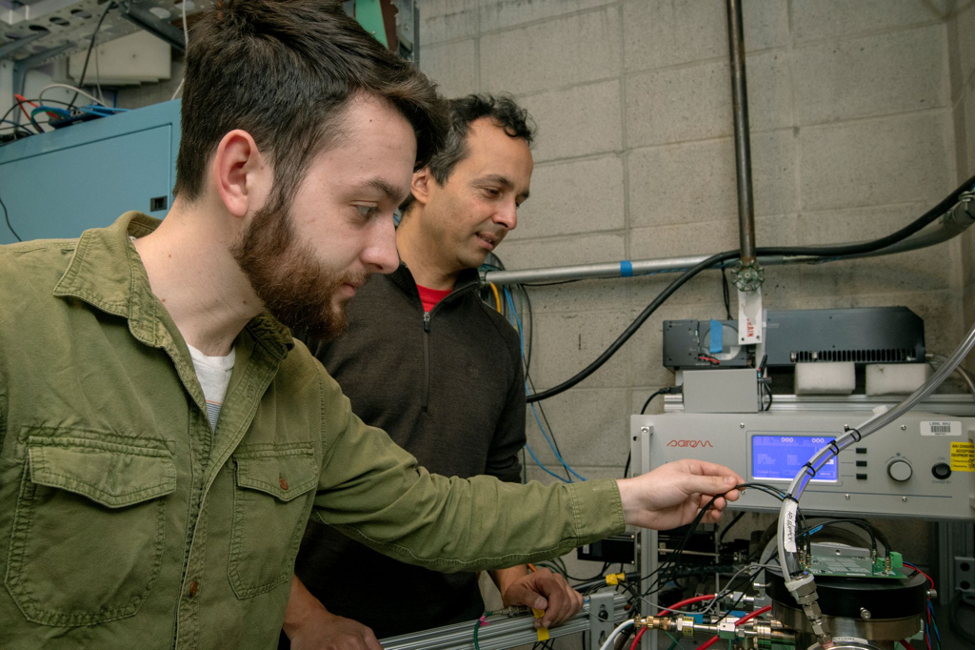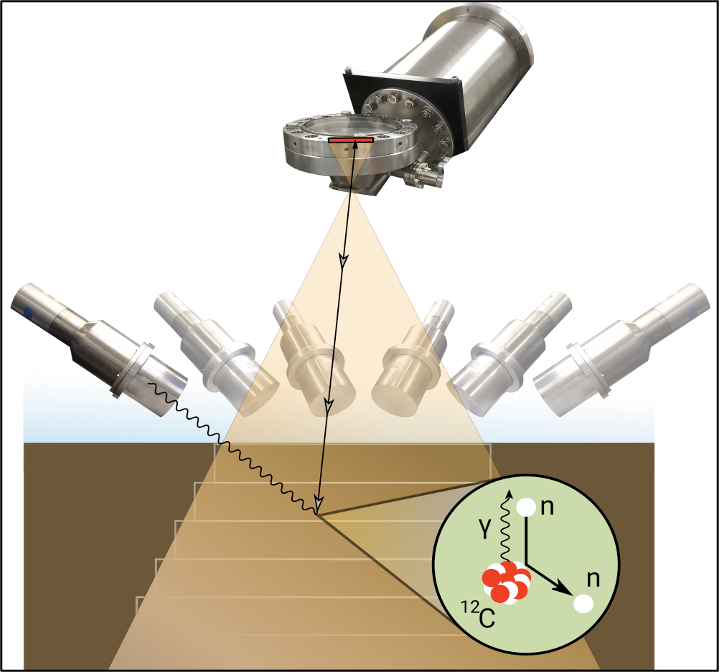Physicists and soil scientists at the Department of Energy’s Lawrence Berkeley National Laboratory (Berkeley Lab) have teamed up to develop a new method for finding carbon stored in the soil by plants and microbes. Unlike all previous methods, this new technique makes it possible to see the carbon in the dirt without digging holes or taking soil samples, like an X-ray for the soil. This new method for measuring carbon pulled out of the air promises to be an important tool for fighting climate change and developing more ecologically friendly forms of agriculture.
“What this instrument really enables is repeated measurements over time,” said Arun Persaud, a Berkeley Lab physicist and one of the leaders of the team. “With our instrument, you can get a very accurate and fast measurement of the total carbon in an acre of land, without disturbing the soil or harming the organisms that live there.”
A plant transfers carbon into the soil as a natural part of its life cycle. Plants breathe in carbon dioxide and breathe out oxygen (which we animals then breathe in). The carbon remains in the plant, used to build molecules and cells it needs to live. A large fraction of that carbon ultimately enters the soil through the plant’s roots. Microbes in the soil then take this carbon and turn it into organic matter that can persist for decades, centuries, or longer.
Plants and soil microbes play a key role in the Earth’s carbon cycle – a cycle that humans have drastically altered. Burning fossil fuels heats up the planet quickly. Human land use for agriculture has depleted organic matter in the soil, resulting in an enormous soil carbon deficit that also contributes to climate change.
Pulling large amounts of carbon out of the atmosphere is a vital component in virtually all plans to limit global warming to 2 degrees Celsius or less. This need is the impetus behind Berkeley Lab’s Carbon Negative Initiative, which aims to develop technologies to capture, sequester, and use carbon dioxide. Plants and microbes are experts on pulling carbon out of the atmosphere – they’ve been doing it for billions of years. But before we can harness them to help manage atmospheric carbon, we need to accurately measure how much carbon is already locked in the soil through plant-microbial interactions, or other management strategies. Unfortunately, existing techniques for testing the carbon content of the soil are quite destructive, and error-prone at large scales.
“We have a major limitation in understanding and quantifying how carbon enters and persists in soil because of the way that we measure it,” said Eoin Brodie, a Berkeley Lab scientist. “Typically we would take a soil core sample from a position in a field and bring it back to the lab. Then we’d basically burn it and measure the carbon that’s released. It’s extremely laborious and costly to do that, and you don’t even know how representative those cores are.”

Brodie is Deputy Director of Berkeley Lab’s Climate and Ecosystem Sciences Division and one of the leaders of the EcoSENSE Program, a component of the Biological & Environmental Program Integration Center (BioEPIC) currently in development. EcoSENSE aims to create suites of sensors to monitor the impacts of climate and weather on ecosystem function, and Brodie and his colleagues wanted to find a better way to measure carbon in the soil. The broad scientific expertise available at Berkeley Lab, and a timely call for proposals on below-ground sensor technologies from DOE’s Advanced Research Projects Agency-Energy (ARPA-E), led Brodie, Persaud, and their colleagues to team up on this project. “What it really took was communication across very different programs at Berkeley Lab,” said Brodie. “We became aware of this potentially useful technology in the Accelerator Technology & Applied Physics (ATAP) Division, and we joined forces.” Ultimately the cross-disciplinary team was awarded a grant from ARPA-E’s Rhizosphere Observations Optimizing Terrestrial Sequestration (ROOTS) program, which enabled this work.
The new method of measurement developed by the Berkeley Lab team eliminates the need to dig anything out of the ground at all. Instead, the as-yet-unnamed device scans the soil with a beam of neutrons. Then a detector senses the faint response of the carbon and other elements in the soil to the neutrons, allowing it to map the distribution of different elements within the soil to a resolution of about five centimeters. All this happens above the ground, with no holes, no cores, and no burning. “It’s like giving the soil an MRI,” said Persaud, who is a staff scientist in ATAP. “We get a three-dimensional picture of the soil and the carbon distribution in it, along with other elements like iron, silicon, oxygen, and aluminum, which are all important to understand the persistence of carbon in soil.”
“What really excites me about this neutron imaging approach is that it lets us effectively and accurately image the carbon distributions in soils at the scales that carbon accounting needs to happen at,” added Brodie. “And we can do it repeatedly over growing seasons, to see how it’s changing with different climates and land management practices. Eventually you could use this to identify what specific land management practices are more effectively drawing carbon down from the atmosphere and storing it in soil.”
“This new carbon sensing method is an example of thinking outside the box and bringing together researchers from diverse backgrounds, here physical sciences and earth science, to create new technology addressing the challenges of climate change,” said Cameron Geddes, director of ATAP.
Right now the project is just emerging from the lab, and Persaud, Brodie, and their colleagues are about to test it in real soils in an outdoor system soon. “We’re really excited to test this on the soil here at Berkeley Lab after the rainy season,” Persaud said.
“The next step is making this process field deployable and more automated, so that it can be incorporated onto things like combine harvesters and tractors, so that this becomes part of the sensing capabilities that you find in farms and across forests,” Brodie added. “There’s really huge, huge potential in this.”
# # #
Founded in 1931 on the belief that the biggest scientific challenges are best addressed by teams, Lawrence Berkeley National Laboratory and its scientists have been recognized with 14 Nobel Prizes. Today, Berkeley Lab researchers develop sustainable energy and environmental solutions, create useful new materials, advance the frontiers of computing, and probe the mysteries of life, matter, and the universe. Scientists from around the world rely on the Lab’s facilities for their own discovery science. Berkeley Lab is a multiprogram national laboratory, managed by the University of California for the U.S. Department of Energy’s Office of Science.
DOE’s Office of Science is the single largest supporter of basic research in the physical sciences in the United States, and is working to address some of the most pressing challenges of our time. For more information, please visit energy.gov/science.
